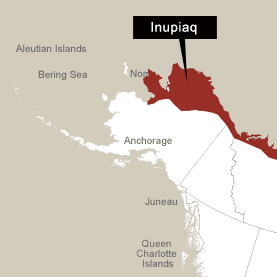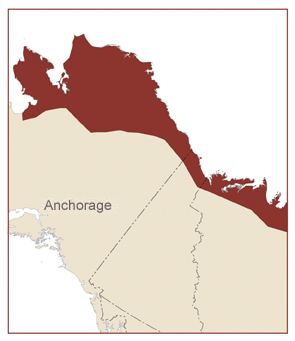
The Inupiaq and the St. Lawrence Island Yupik People, or “Real People,” are still hunting and gathering societies. They continue to subsist on the land and sea of north and northwest Alaska. Their lives continue to evolve around the whale, walrus, seal, polar bear, caribou and fish.
Traditional clothing consisted of outer and inner pullover tops (parkas or kuspuks / qiipaghaq – the outer garment); outer and inner pants, socks, boots (kamiks). Tops and pants were made of caribou skin, with the fur facing inward on inner garments and outwards on outer. The woman’s pullover had a larger hood for carrying small children, except on St. Lawrence Island, where they do not carry the baby in the parka. Gloves were made from various skins, with the fur turned inside and usually connected with leather strip around the neck. Waterproof outer garments made from sea-mammal intestines completed the wardrobe.
The people used a variety of designs and materials, but three key features were common:
- An underground tunnel entrance below the living level to trap cold air;
- A semi-subterranean structure, using the ground as insulation.
- A seal-oil lamp from soapstone or pottery, for light, heat and cooking. Homes were usually made from sod blocks, sometimes laid over driftwood or whalebone and walrus bone frames, generally dome-shaped. The shape was usually rectangular, except on St. Lawrence Island where the houses were circular of varying sizes. The rectangular houses generally were 12-15 ft. x 8-10 ft., holding 8 to 12 people. In the summer many of these houses flooded when the ground thawed, but most people had already moved to their summer camps.
- Community houses, called qargis, were used as a work area in Inupiaq settlements.
The traditional Inupiaq and St. Lawrence Island Yupik tool kit had a variety of stone, wood, bone and ivory tools made for butchering, tanning, carving, drilling, inscribing, sharpening and flaking. The bow drill was an important tool, used for starting fires, drilling holes in wood, bone, ivory. Hunting equipment and tool kits are kept in different containers.
 A sophisticated package of toggle-headed harpoons, lances, lines, and seal bladder floats was used for the bowhead whale hunt. Seal skin floats are used for whale hunts, as are water-filled seal bladders which attract and lead bowhead whales closer to the shore.
A sophisticated package of toggle-headed harpoons, lances, lines, and seal bladder floats was used for the bowhead whale hunt. Seal skin floats are used for whale hunts, as are water-filled seal bladders which attract and lead bowhead whales closer to the shore.
- Other tools include scratching boards for attracting seals to breathing holes, bows, arrows, spears, spear throwers, bolas for taking birds, snares.
- Fishing gear includes nets, traps made from branches and roots, hooks.
Both groups believe in reincarnation and the recycling of spirit forms from one life to the next, both human and animal. Names of those who died recently are given to newborns.
Only if animal spirits are released can the animal be regenerated and return for future harvest. This explains the elaborate treatment of animals killed, even today.
Source: Text Copyright of the Alaska Native Heritage Center website
